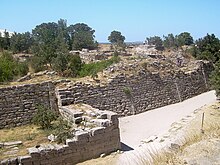The Trojan War was supposedly fought over the city of Troy in today's Turkey in the 12th century BC, and inspired several great epics, in particular, the Iliad and Odyssey and the Aeneid. While historians debate whether the Trojan War happened, it is among the best-known stories of the ancient Mediterranean and part of the founding myth of both ancient Greece and the Roman Empire.
Understand
edit- See also: Greek and Roman mythology

The Iliad and the Odyssey, written in the 9th century BC and attributed to Homer, are among the oldest surviving pieces of literature from ancient Greece, and are often considered the beginning of European literary canon. The stories contain supernatural elements such as gods and monsters, but also realistic details about warfare and daily life in pre-classical Greece.
The Iliad describes the Achaeans' ten-year siege of Troy, omitting both the beginning and the conclusion of the war. The Odyssey describes Odysseus' (Ulysses in Latin) disastrous ten-year journey back to his hometown Ithaca, making landfall at many places around the Mediterranean. Some of those locations can be identified in the real world, but in Hellenistic Greece, others were either forgotten or dismissed as fictional. Some famous tropes of the Trojan war, such as the abduction of Helen the Fair and the Trojan horse, are absent from the Iliad, and mentioned briefly in the Odyssey.
The Aeneid, written by Virgil in the 1st century BC, retells the war through the Trojan hero Aeneas and describes him migrating to Italy, becoming an ancestor of the Romans.
The epics describe the abduction of Helen, wife of Menelaus the king of Sparta, by Paris, a Trojan prince, sparked enmity between the Trojans and the Achaeans from across the Aegean Sea. Having been unable to break into the defensive walls of the city, the Achaeans decided to set up a trick—they offered a huge wooden horse as a gift to the Trojans, as amends for the bother they caused with their war galleys on the city's beach. The Trojans accepted the offer sincerely, but this resulted in them losing their city, as inside of the horse were of Achaean soldiers, ready to fight, and now right in the centre of the city.
Legacy
editThe Trojan War has inspired countless pieces of art (including early modern European art), prose, theatre and motion pictures until today.
Destinations
edit- 1 Troy (Turkey). The city besieged in the Iliad. Troy has been inhabited since at least 3000 BC, deserted and re-settled many times, but never forgotten. Excavated since the 19th century.
- 2 Aeolian Islands (Italy). Island of Aeolus of the Odyssey.
- 3 Sicily (Italy). Home of the cyclops of the Odyssey.
- 4 Ithaca (Greece). Odysseus' hometown.
- 1 Trojan Horse (Çanakkale, Turkey). The one that was used in the movie Troy was donated to the city. Free.
- 2 Cave of Nestor (south of bay of Voidokilia, Pylos, Greece).
- 3 Mount Circeo (Italy). A 541 m high promontory connected with the Greek myth of Circe, the goddess of magical potions mentioned in Homer's Odyssey.
See also
edit- Exodus of Moses, another legendary journey at the Mediterranean, supposed to have happened a century or so before the Iliad

